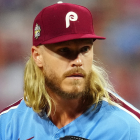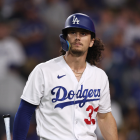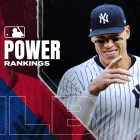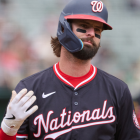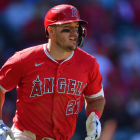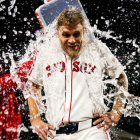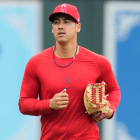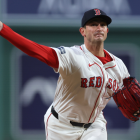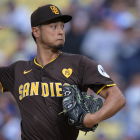
The end of the World Series means that Major League Baseball's offseason has arrived. Tomorrow, free agency will officially open, allowing players and teams to negotiate without restriction. Earlier this week, in preparation for what's to come, CBS Sports published its annual ranking of the winter's top 50 free agents.
Anyone who perused our rankings might've noticed that several notable names were excluded. We're big believers in transparency around these parts, especially when it comes to these kinds of exercises. As such, below we've laid out our thinking behind leaving off 10 former All-Stars. (The players are presented in alphabetical order.)
1. Brandon Belt, 1B
Belt, who did not play after Aug. 20 because of knee woes, has conceded he may retire this winter if his ailment doesn't improve. (Count Giants broadcaster Duane Kuiper among those who believe he's finished.) Even if Belt returns, it's unclear how much he has left to offer. He had the worst season of his career by OPS+, and he's a complete nonfactor against velocity. Indeed, Belt ranked in the second percentile in exit velocity against pitches 95 mph or greater, putting him in company with the likes of light-hitting (to be kind) infielders Nick Allen and Vidal Bruján. If this is the end -- and it may be, one way or another -- Belt deserves his flowers for a good career.
2. Matt Carpenter, 1B
The author of one of the most fun stories in baseball this season, Carpenter failed to make the Rangers out of spring training, only to surface in-season for a Ruthian run with the Yankees. He homered 15 times in 47 games, thanks in part to a pull-happy approach, before breaking his foot on Aug. 8. Carpenter returned for the postseason, but struck out nine times in 12 plate appearances. Given his age (he'll turn 37 this month) and his unchanged ball-tracking metrics (his average exit velocity dropped year-to-year), we're inclined to bet against him sustaining his home-run barrage.
3. Joey Gallo, OF
Gallo seemed like a stone-cold lock for the top 50 (heck, the top 10) as recently as the 2021 trade deadline. Since then, his performance has cratered -- to the extent that the 83 OPS+ he posted in 44 games with the Dodgers counted as an improvement. Gallo, about to enter his age-29 season, will get another chance at course-correcting. The range of outcomes is simply too wide for us to justify ranking him in the top 50.
4. Zack Greinke, RHP
Greinke had a productive year in his return to Kansas City, recording a 111 ERA+ in 137 innings. The latest indication is that he intends to return for his age-39 season. While we hope that he pitches as long as he desires, it's hard to rank him as a priority free agent given the perilous nature of his game. Greinke is running on guts and wits and little else anymore. He doesn't miss bats or suppress quality contact (he ranked in the 2nd percentile in whiff rate and in the 39th in average exit velocity), and the state of his arsenal is such that he has to be precise with his location to avoid damage. Greinke proved up for the challenge in 2022, but it's hard to count on that continuing.
5. Mitch Haniger, OF
When people talk about sports being a glorified random number generator, they usually don't mean with regards to injuries. They could, though, in the case of someone like Haniger. Here are his games played totals by season over the last five years: 157, 63, zero, 157, and 57. There's no telling how often Haniger will play in any given season. That's too bad. He's a good hitter whenever he's able to take the field.
6. Andrew McCutchen, OF
McCutchen, now 36, spent most of the season as the Brewers' designated hitter. He homered 17 times (putting him 13 away from 300 for his career) en route to a 99 OPS+. That's all good and well, and we only wish it was part of a total resurgence. Unfortunately, the limitations that inspired us to leave him off last winter's top 50 remain in place. Put simply, McCutchen isn't a good enough hitter against right-handers anymore to merit an everyday spot in the lineup. To wit, he hasn't posted an OPS of .700 or better with the platoon disadvantage since 2019, and it's not because of a lack of opportunity: he's taken nearly 1,000 plate appearances against righties in that time. Factor in how McCutchen doesn't offer much defensive or baserunning value these days, and his optimal usage entails a part-time role. We hope he finds one, as he's always been a joy to watch play ball, but Father Time is undefeated for a reason.
7. Gary Sánchez, C
Giving Sánchez a fresh start, away from the New York media market and the ghosts of past expectations, seemed like a reasonable gamble on paper. It just didn't work out for the Twins. Instead, Sánchez launched 16 home runs, the fewest he's ever hit while appearing in 100-plus games, and finished with an 89 OPS+. Sánchez remains capable of striking the ball with authority, but most of the reminders he offered this season came only on pitches located middle-away. His swing-and-miss issues were ever present, however, and a greater share of his contact was of the weak variety. Defensively, Sánchez's framing graded better than it has in years; alas, it was still only average. Maybe another coaching staff can unlock his 30-plus-homer upside again, or, maybe, this is him and 2019 was the outlier.
8. Carlos Santana, DH
Santana split the season between the Royals and the Mariners, hitting for a 100 OPS+ on the nose thanks to a 14 percent walk rate. His eye remains sharp, to say the least, and he continues to show a good feel for making contact. We're certainly open to the argument that Santana will benefit from the new defensive-positioning restrictions, too, seeing as he approaches a .300 wOBA against the shift as a left-handed hitter. Even so, you can forgive us for being reluctant to rank a soon-to-turn 37-year-old DH with an 89 OPS+ in the Pandemic Era.
9. Noah Syndergaard, RHP
Syndergaard's first full season since 2019 saw him pitch 25 times and amass a 103 ERA+ and a 3.06 strikeout-to-walk ratio. Those are respectable marks, of course, but we have reservations about how he reached them. Syndergaard leaned into pitching to contact, especially after a trade to the Phillies. Over the course of his final 10 outings, he had an 84.1 percent contact rate. For reference, no pitcher with at least 10 starts this season had a full-season contact rate higher than 83.7 percent. If this is Syndergaard's new normal, he'll be sailing in uncharted territories. We're not sure how or if that's going to play, so we decided to leave him off instead of ranking him in the 40s.
10. Mike Zunino, C
Zunino didn't get a real chance to follow up on his breakout 2021 campaign, limited to just 36 games before having to undergo surgery to repair his thoracic outlet syndrome. When Zunino did play, he offered his usual: tons of strikeouts, a few walks, and good framing. (All of those were present in 2021, too, he just homered twice as often as he normally does.) He's probably not going to return to his All-Star form on a regular basis, but it's a weak catching market and he deserves a job somewhere.













